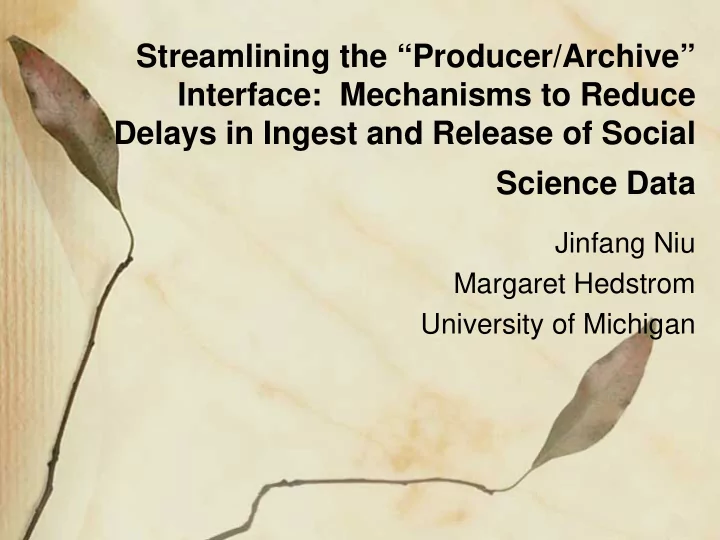

Streamlining the “Producer/Archive” Interface: Mechanisms to Reduce Delays in Ingest and Release of Social Science Data Jinfang Niu Margaret Hedstrom University of Michigan
Outline Background Research questions Methodology Findings & discussions
Data sharing is a growing concern Government policies OECD FOIA Funding agencies NIH, NSF, ESRC Journals
Sharing data through data archives Long-term preservation Data archivists help both depositors and users Make it possible for meta-analysis Improve the visibility and possibly the citation rate of data.
Sharing model through data archives Depositors (Prepare & deposit) Archive (process & disseminate) Users
Good data archiving practice Data producers Deposit in the appropriate data archive Prepare data well Deposit in a timely manner Data archive Processes and releases data for public use as soon as possible Users Gain access to deposited data as soon as possible Use data without too many difficulties
Research questions Do producers deposit data in a timely manner? How quickly does the archive release data to the public? What causes the delays? How to improve the situation?
Methodology Analysis of delays (n = 184 data sets) Deposit Delays Processing Delays Causes Submission and processing procedures Incentive issues for depositors Proposed Solutions
Delays Deposit delay the number of days between the date a grant was closed and the date that the data archive received the data. Processing delay the number of days between the date when the data arrive at the archive and the date when the data is released to the public.
Delays (in days) Mean Median Min Max 767 664 -27 2630 Deposit delay 355 276 20 1187 Processing delay Total 1160 1122 263 2846
Causes of deposit delay Two-step submission procedure Data depositor funding agency archive No clear timeline for deposit No effective incentive mechanisms
Processing Delay vs. Actual Processing Time (in days) Mean Median min max Processing time 10 7.5 1 45 Processing delay 355 276 20 1187
Causes of processing delays Depositors submit incomplete data and documentation Depositors review the processed data. Funding agency delays transmission of final reports to the data archive Extremely large data sets require more time to process and delay processing of other data sets in the queue
Proposed solutions - 1: Streamline submission process Change the data submission procedure Stipulate a clear timeline for deposit Improve the awareness and availability of documentation guidelines
Proposed solutions - 2: Incentives Punishment Coercive and uniform Pros and cons: Makes all data accessible to the public. All data producers have to prepare and deposit data to avoid punishment even if their data sets are not likely to be used.
Cumulative and Average Monthly Access Rates for the 10 Most Frequently (Top 10) and 10 Least Frequently (Bottom 10) Accessed Data Sets. Cumulative Average (per month) Top 10 Bottom 10 Top 10 Bottom 10 5185 27 1037 3 2345 25 260 2.8 2234 24 319 2.7 1651 24 183 2.7 1623 23 232 2.6 1328 21 148 2.3 1267 20 271 2.2 1229 16 137 1.8 932 14 104 1.6 851 11 95 1.2
contrast of acce 1200 1000 800 top 10 600 bottom 400 200
Proposed solutions - 2: Incentives Rewards Inducive and selective Pros and cons: Related to the actual use of data Difficult to anticipate actual use. Not all data are accessible to the public
Future research Exploration of appropriate punishment & reward mechanisms Proposed mechanisms Hold back a portion of grant funding Make future funding contingent on data deposit Citation of data Include data deposit in performance evaluation
Thanks! This research was supported by the National Science Foundation (NSF Award Number IIS-0456022) as part of a larger project entitled “ Incentives for data producers to created archive-ready data sets. ”
Recommend
More recommend